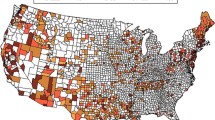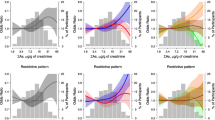Abstract
Objective: Lung cancers have been observed among patients of arsenic intoxication since the 1950s, but data on the dose–response relationship were limited. In order to obtain such data, a study was conducted in ten townships in Taiwan. Methods: Measurements of arsenic levels in drinking water were available for 138 villages from a census survey conducted by the government. Certificates of deaths that occurred in the villages between January 1, 1971 and December 31, 1990 were reviewed, and 673 male and 405 female mortality cases of lung cancer were identified. Multi-variate regression models were applied to assess associations between arsenic levels in drinking water and mortality of lung cancer using village as the unit. Results: After adjusting for age, arsenic levels above 0.64 mg/l were associated with a significant increase in the mortality of lung cancer in both genders, but no significant effect was observed at lower levels. Post-hoc analyses confirmed such a dose–response relationship. Conclusions: The results indicate a prominent carcinogenic effect of high arsenic levels in drinking water on the lung and suggest the new ‘maximum contaminant level’ of 10 μg/l published by the US Environmental Protection Agency provides sufficient protection against lung cancer. Nonetheless, further studies with exposure data on individuals are warranted to confirm these findings.
Similar content being viewed by others
References
World Health Organization(1993) WHO Guidelines for Drinking Water Quality, Vol. 1. Geneva, Switzerland: World Health Organization.
Environmental Protection Agency(2001) National primary drinking water regulations; Arsenic and clari.cations to compliance and new source contaminants monitoring; Final rule. Fed Reg 66: 6076-7066.
Morales KH, Ryan L, Kuo T-L, Wu M-M, Chen C-J (2000) Risk of internal cancers from arsenic in drinking water. Environ Health Perspect 108: 655-661.
Wu M-M, Kuo T-L, Hwang Y-H, Chen C-J (1989) Dose-response relation between arsenic concentration in well water and mortality from cancers and vascular diseases. Am J Epidemiol 120: 1123-1132.
Environmental Protection Agency(2001) National primary drinking water regulations; arsenic and clari.cations to compliance and new source contaminants monitoring: delay of e.ective date; Final Rule. Fed Reg 66: 28341-28350.
Hutchinson J (1887) Arsenic cancer. Br Med J 2: 1280-1281.
Sommers SC, McManus RG (1952) Multiple arsenical cancers of skin and internal organs. Cancer 6: 347-359.
Tseng W-P, Chu H-M, How S-H, Fong J-M, Lin C-S, Yeh S (1968) Prevalence of skin cancer in an endemic area of chronic arsenicism in Taiwan. J Natl Cancer Inst 40: 453-463.
Tseng W-P (1977) E.ects and dose-response relationship of skin cancer and blackfoot disease with arsenic. Environ Health Perspect 19: 109-119.
Environmental Protection Agency(1984) Health Assessment Document for Inorganic Arsenic: Final Report. Washington, DC: US Environmental Protection Agency.
Risk Assessment Forum (1988) Special Report on Ingested Inorganic Arsenic: Skin Cancer; Nutritional Essentiality. Washington, DC: US Environmental Protection Agency.
Lo M-C, Hsen Y-C, Lin B-K (1977) Second Report on the Investigation of Arsenic Content in Underground Water in Taiwan. Taichung, Taiwan: Taiwan Provincial Institute of Environmental Sanitation.
American Public Health Association(1985) Standard Methods of the Evaluation of Water and Water Waste. Washington, DC: American Public Health Association.
Kuo T-L (1996) Investigation on the arsenic levels in well water in the blackfoot disease endemic area. Chin J Public Health 15: s116-s125.
Guo H-R (1999) Dose-response relation between arsenic in drinking water and mortality of bladder cancers. Chin J Public Health 18: s134-s139.
Guo H-R, Chiang H-S, Hu H, Lipsitz SR, Monson RR (1997) Arsenic in drinking water and incidence of urinary cancers. Epidemiology 8: 545-550.
Guo H-R, Lipsitz SR, Hu H, Monson RR (1998) Using ecological data to estimate a regression model for individual data: the association between arsenic in drinking water and incidence of skin cancer. Environ Res 79: 82-93.
Rosenbaum PR, Rubin DB (1984) Di.culties with regression analysis of age-adjusted rates. Boimetrics 40: 437-443.
Ferreccio C, Gonzalez C, Milosavjlevic V, Marshall G, Sancha AM, Smith AH (2000) Lung cancer and arsenic concentrations in drinking water in Chile. Epidemiology 11: 673-679.
Tsuda T, Babazono A, Yamamoto E, et al. (1995) Ingested arsenic and internal cancer: a historical cohort study followed for 33 years. Am J Epidemiol 141: 198-209.
Ferreccio C, Gonzalez Psych C, Milosavjlevic Stat V, Marshall Gredis G, Sancha AM (1998) Lung cancer and arsenic exposure in drinking water: a case-control study in northern Chile. Cadernos de Saude Publica 14: 193-198.
Smith AH, Goycolea M, Haque R, Biggs ML (1998) Marked increase in bladder and lung cancer mortality in a region of Northern Chile due to arsenic in drinking water. Am J Epidemiol 147: 660-669.
Cuzick J, Sasieni P, Evans S (1992) Ingested arsenic, keratoses, and bladder cancer. Am J Epidemiol 136: 417-421.
Lüchtrath H (1983) The consequences of chronic arsenic poisoning among Moselle wine growers. J Cancer Res Clin Oncol 105: 173-182.
Luo F-J, Luo Z-D, Ma L (1995) A study on the relationship between drinking water with high arsenic content and incidence of malignant tumour in Heihe Village, western part of Huhehot, Inner Mongolia. Chin J Epidemiol 16: 289-291.
Hopenhayn-Rich C, Biggs ML, Smith AH (1998) Lung and kidney cancer mortality associated with arsenic in drinking water in Cordoba, Argentina. Int J Epidemiol 27: 561-569.
Enterline PE, Day R, Marsh G (1995) Cancers related to exposure to arsenic at a copper smelter. Occup Environ Med 52: 28-32.
Stöhrer G (2001) Re: risk assessment of internal cancers from arsenic in drinking water. Environ Health Perspect 109: A571.
Buchet JP, Lison D (1998) Mortality by cancer in groups of the Belgian population with a moderately increased intake of arsenic. Int Arch Occup Environ Health 71: 125-130.
Last JM (2001) A Dictionary of Epidemiology, 4th edn. Oxford, UK: Oxford University Press.
Author information
Authors and Affiliations
Rights and permissions
About this article
Cite this article
Guo, HR. Arsenic level in drinking water and mortality of lung cancer (Taiwan). Cancer Causes Control 15, 171–177 (2004). https://doi.org/10.1023/B:CACO.0000019503.02851.b0
Issue Date:
DOI: https://doi.org/10.1023/B:CACO.0000019503.02851.b0




